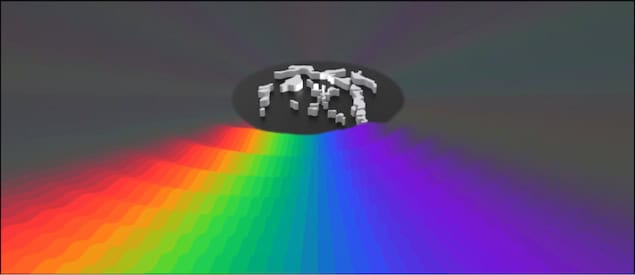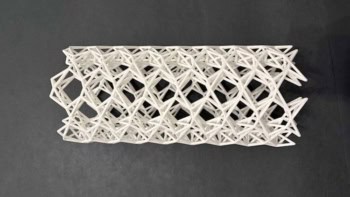
Researchers in Denmark have produced the acoustic equivalent of a rainbow, creating a structure that spatially decomposes sound into its component frequencies in free space. Developing such a structure had proven difficult due to the complexity required, but the team at Danmarks Tekniske Universitet (DTU) managed it thanks to an advanced structural design technique. The new architecture could be used to make devices tailored to emit or receive certain frequencies of sound.
Optical rainbows occur when white light is split into its different spectral components, for example by passing through dispersive media such as prisms or droplets. Although acoustic rainbows are less well-known, they follow the same principle, being the spatial decomposition of sound in free space where waves oscillating at different frequencies propagate in different directions. They have previously been created in confined media using arrays of resonant structures that “trap” sound at different positions in space depending on their frequency. Examples include waveguides, solid and/or fluid mixtures and devices known as acoustic circulators.
Acoustic spectral decomposition also occurs in several natural structures, including the outer ear structures, or pinnae, of mammals such as bats, cetaceans and primates. Indeed, the pinnae of primates (including humans) have an intricate geometry that generates complex interference phenomena via scattering of sound waves, thereby enabling the animals to localize external sources of sound.
An acoustic scattering structure
While researchers have previously attempted to imitate such biological designs, these efforts were largely unsuccessful. The new work, which was co-led by Rasmus Ellebæk Christiansen and Efren Fernandez-Grande at the DTU, succeeded in part thanks to a new technique known as computational morphogenesis, or topology optimization.
This technique, which the researchers describe in Science Advances, builds on an earlier morphogenetic design framework for tailoring passive acoustic scattering structures with dimensions on the order of a few wavelengths. Using an iterative process, the team spatially redistributed sound-reflecting material in an air background inside a specified region of space. This enabled them to tailor the sound field emitted from the created structure to match a predefined target emission pattern across a specified frequency band, mimicking naturally-occurring “sound shaping” structures.
“Such a technique is possible today thanks to the rapid growth in computational power in recent years that has allowed us to model and synthesize sound on the large scale,” Ellebæk Christiansen explains. When combined with advanced production techniques like additive manufacturing (also known as 3D printing), he adds that the team benefitted from “nearly unlimited design freedom”, with the new technique enabling the design of metamaterials and nonintuitive structures hitherto deemed unrealizable.
“Our approach to designing the structures is to re-formulate the device design problem carefully and meticulously as a mathematical optimization problem and to use topology optimization to solve this problem,” he explains. “In this way, we do not rely on simplified design rules derived from underlying physics models, on design intuition or on prior design experience to come up with our device geometry. Instead, we use rigorous mathematical modelling and simulation coupled with advanced numerical algorithms.”
Towards new and very different structures/geometries
The geometry and topology of the metamaterial the team created has several features reminiscent of structures present in the pinnae that spatio-spectrally decompose sound, Ellebæk Christiansen says. However, he tells Physics World that the technique may also enable them to develop structures/geometries that offer new possibilities never realized in nature.

Sound waves control droplet movement in microfluidic processor
One option, Fernandez-Grande suggests, would be to design acoustic materials that reflect different frequencies of sound in different ways – for example, by scattering high frequencies diffusely and redirecting low frequencies towards an absorbing surface. “It might also help in the development of acoustic lenses – that is, sound sources (such as loudspeakers) that control how different frequencies are radiated in space,” Fernandez-Grande adds.
In the future, the researchers would like to transition from their current two-dimensional design to one that is fully three-dimensional. “This would offer significantly more design freedom, and acoustic field complexity, which might allow for even better/more elaborate spatio-spectral sound field control,” Ellebæk Christiansen says.



